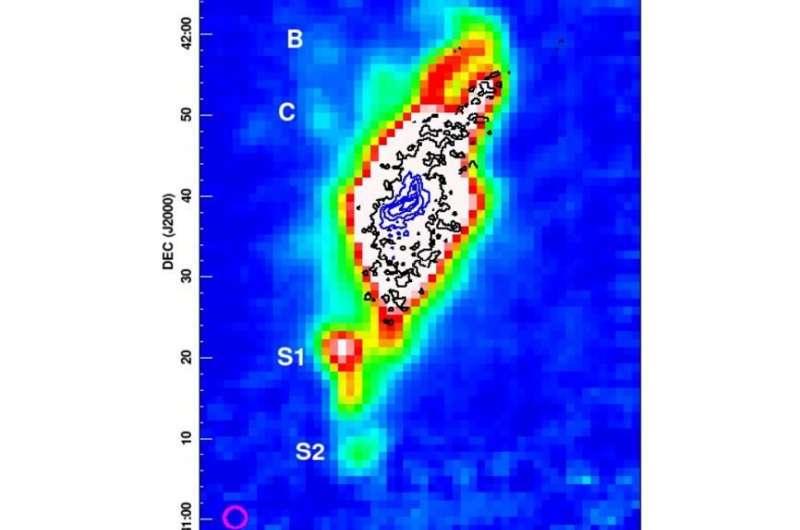May 8, 2023 report
This article has been reviewed according to Science X's editorial process and policies. Editors have highlighted the following attributes while ensuring the content's credibility:
fact-checked
peer-reviewed publication
trusted source
proofread
Long tidal tails detected in the galaxy pair Arp 269

Using the Five-hundred-meter Aperture Spherical radio Telescope (FAST), Chinese astronomers have observed a pair of galaxies known as Arp 269. They detected extended tidal tails emerging from this system. The finding was reported in a paper published April 28 on the arXiv pre-print repository. The article has been accepted for publication in Monthly Notices of the Royal Astronomical Society.
Tidal tails are thin, elongated regions of stars and interstellar gas extending into space. They are formed as a result of gravitational interactions between galaxies and star clusters. The observations show that some interacting objects have two distinct tails, while other systems have only one tail.
Located some 23 million light years away, Arp 269 (also known as NGC 4490/85) is a low-mass merging galaxy pair consisting of a smaller irregular galaxy NGC 4485 and a larger barred spiral galaxy NGC 4490. Previous observation of this system found that it is embedded in a very extended, low-density envelope of neutral hydrogen (HI). This envelope is elongated and extended for a total length of about 290,000 light years, and it is approximately perpendicular to the NGC 4490 disk.
Recently, a team of astronomers led by Yao Liu of the Chinese Academy of Sciences (CAS) have investigated Arp 269 with FAST, finding more tidal features in this galaxy pair.
"With FAST's superior sensitivity, we discover much more diffuse HI structures in the interacting galaxy pair NGC 4490/85," the researchers wrote in the paper.
FAST observations found that the tidal tails in Arp 269 are much longer than that seen during previous observations. They extend in both the south and north directions, reaching together a size of about 325,000 light years. The astronomers noted that it is not surprising to see such two long tails in Arp 269 as such structures are one of the most common features seen in closely interacting pairs.
Trying to explain the origin of the detected tidal tails, the researchers underlined that the velocity structure of the northern tails matches that of NGC 4485. Therefore, it is very likely that the tails are the debris torn out from the NGC 4485 disk due to interaction with the NGC 4490 galaxy.
Furthermore, the study detected a collimated gas component pointing at a nearby dwarf galaxy known as KK 149, located about 160,000–200,000 light years away from NGC 4490. This suggests that KK 149 might also be interacting with Arp 269.
According to the authors of the paper, FAST observations also allowed them to identify several tidal features in the gas envelope of Arp 269, which is connected with a starburst low-metallicity dwarf galaxy designated MAPS 1231+42. The results indicate that MAPS 1231+42 is clearly associated with the tidal debris of the interacting pair NGC 4490/85.
More information: Yao Liu et al, FAST discovery of long tidal tails in NGC 4490/85, arXiv (2023). DOI: 10.48550/arxiv.2304.13964
Journal information: Monthly Notices of the Royal Astronomical Society , arXiv
© 2023 Science X Network





















